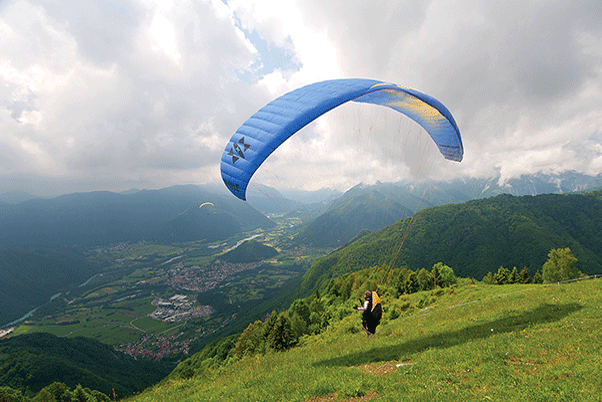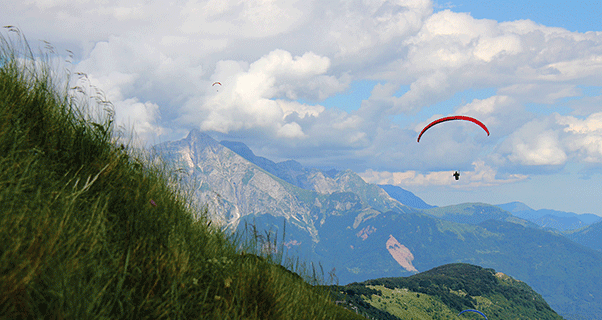
Guide to Tolmin, Slovenia
14 March, 2014- Easy and reliable mountain flying
- The home of many distance records
- Best from May to early June, or late July to September
- A good set-up to support free flying

WHY GO?
Smaller than the French or Swiss Alps, but still full of XC potential
WHERE IS IT?
WHAT’S IT LIKE?
This is the Julian Alps: smaller than the French Alps but still mountainous and still very beautiful. Flying XC is easy and reliable here, but don’t be fooled into thinking it’s only for beginners. Slovenia holds a major share of the world records on offer, particularly in out-and-return, with pilots covering 200km flying into Italy and back.
The Tolmin/Kobarid valley is the most famous flying arena in Slovenia, and encompasses a section of the world record route. The launches are Stol, near Kobarid, and Kobala, near Tolmin, at the other end of the east/west valley. Shuttle buses run to launch in season.
The valley is one of the most scenic and memorable in Europe, with its gently flowing river down the centre and a good retrieve road either side. You can see the Dolomites to the west on a clear day, but the region is dominated by 3,000m Triglav to the north.
[youtube id=”pCJq2JF_-aE” w=”602″]
Launches and landings are grassy and well maintained with good windsocks, clear noticeboards and local club members often on hand. To help keep everything nice, site fees of €3 or €4 are applied on some sites, with weekly and seasonal passes available. In case of emergency, mountain rescue is free in Slovenia.
Three of the current world out-and-return records were set here (Arduino Persello’s 280km in June 2012; Nicole Fedele’s 259.7km women’s record and Brett Janaway’s tandem 205.7km, both in August 2013). The record flights start from Sorica take-off. It’s high (1,470m) but short, steep and rough, so can be intimidating for beginners. Just 10km to the west is the much more user-friendly Kobala launch (1,080m). Kobala is big and grassy, and suitable for pilots of all abilities. Try an out-and-return, running the front ridge west towards Gemona or beyond, then drop onto the mountains behind for the return leg.
FLYING CONDITIONS
The season starts in late March or early April, depending on winter snowfall and when the tracks open. The season goes through to September, sometimes later. June can sometimes be quite stable, but it becomes unstable again late July and in August – this is when the majority of world records have been set.
The air in Slovenia is never that rough or rowdy and pleasant flights are enjoyed by most levels of pilot.
Forty minutes further south pilots can enjoy thermalling all year round at a site called Lijak. It’s part of a 35km ridge where pilots regularly clock up 100km OLC flights in every month of the year. Great for February or March getaways.
WHEN TO GO
Your best chances are in May to early June, and from late July to September.
ALTITUDE
Kobala: launch at 1,080m, landing at 160m
Stol: launch at 1,425m, landing at 230m
Sorica: launch at 1,470m, landing at 840m
Cloudbase: early season 2,200m, 2,800m max in late season
HANG GLIDER ACCESS
Yes, Kobala or Stol both accept HG, as do the shuttles. Grass launch, not ramps.
MUST BE FLOWN
The 55km out-and-return from Kobala to Stol or vice-versa. This is the big highway of the valley, passing the mighty vertical rockfaces of Krn, the highest mountain in the region.
To make it a 100km, extend the flight from Kobala all the way to Gemona in Italy. For the true aviators, fly Kobala to Gemona, then return but move into the big mountains, dropping over the main spine to land at the lakeside of Bohinj lake for a pleasant swim after an amazing 120km flight in some of the most breathtaking areas of the country. Only for those who understand mountain flying!
DANGERS AND ANNOYANCES
The biggest danger is the schnapps. It’s vicious! Be careful of dropping into the big mountains – you might have a long walk out.
ACCOMMODATION
Loads, from camping to hostels, B&Bs and hotels. Consider the pilots’ hotel www.jelkin-hram.com.
Camping: www.kamp-koren.si and www.camp-gabrje.com
GUIDES AND COURSES
Most local schools are run by the clubs on a part-time basis. There are no full-time commercial schools.
For guiding, call on Brett Janaway of xTc Paragliding. He’s been there for a decade and can sort everything out for you.
For more independent pilots, check in with part-time guide www.jelkin-hram.com.
TAKE THE FAMILY
Perfect for holidays. Swimming, bike riding, water sports, museums, walking are all on offer locally. Further afield, the capital Ljubljana is well worth a visit, while Venice is about two hours away.
WEATHER INFO
Think of the Julian Alps as a miniature French Alps. Everything is on a smaller scale. The weather doesn’t get as severe, but then it doesn’t get as epic either. It therefore has a generous amount of flying days throughout the season without ever being too uncomfortable.
Lots of weather info on xtc-paragliding.com. Talking weather stations in English at www.sffa.org/en/index.php/weather-stations.
GETTING THERE
Trieste Airport (Italy) is 45 minutes’ drive. Ljubljana Airport (Slovenia) is 90 minutes away. Most pilots drive. If using public transport however, buses are easier to use than the trains.
USEFUL CONTACTS AND WEBSITES
Local Association
Tolmin paragliding club
Kobarid paragliding club
Tourist offices
Mountain rescue: Call 112
• Got news? Send it to us at news@xccontent.local
Buy and sell gear on Skyads.aero








